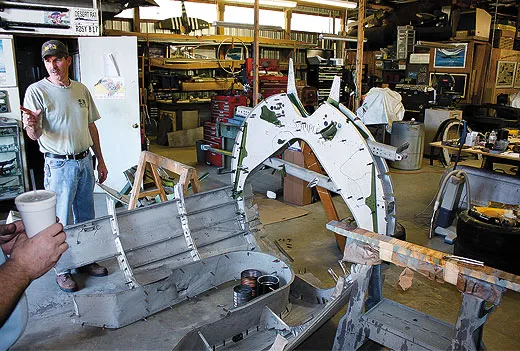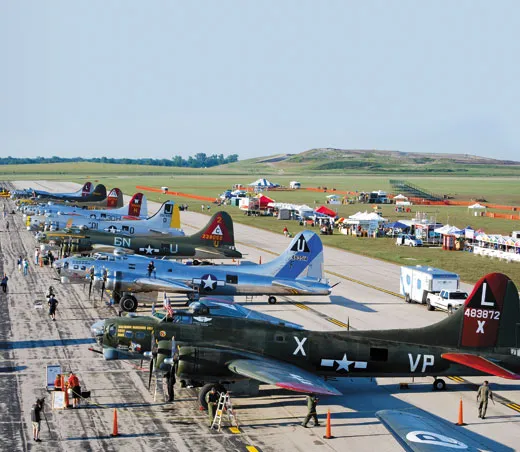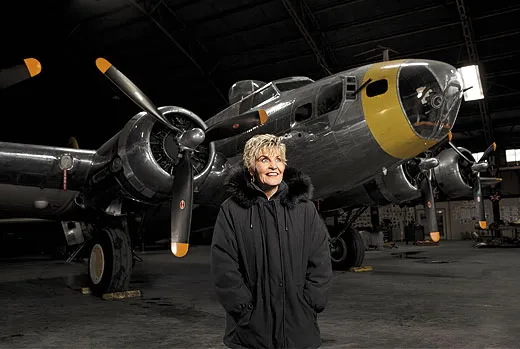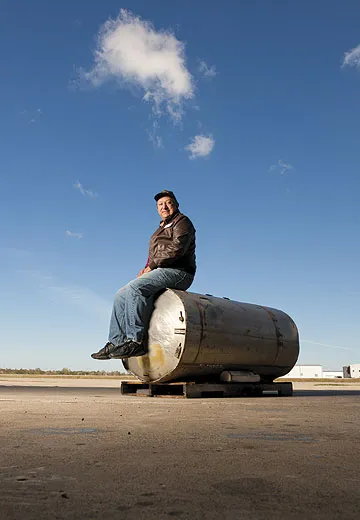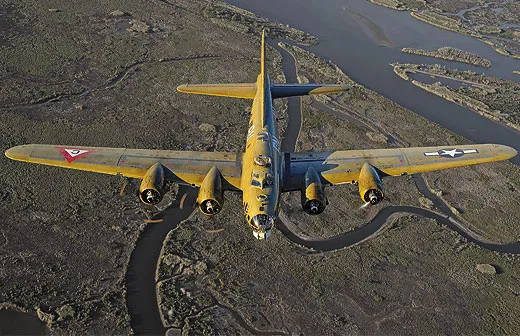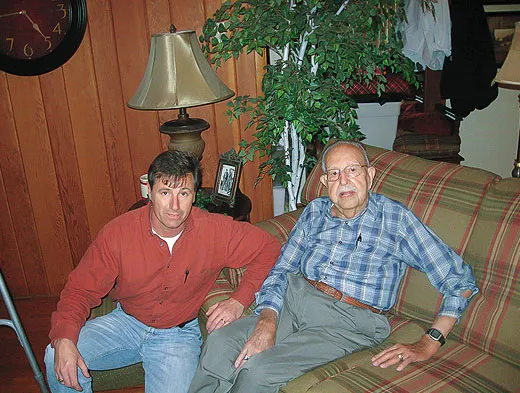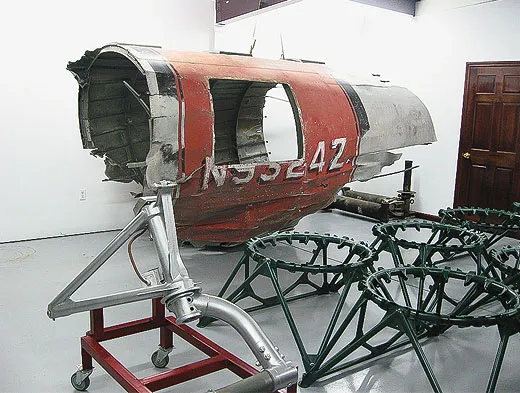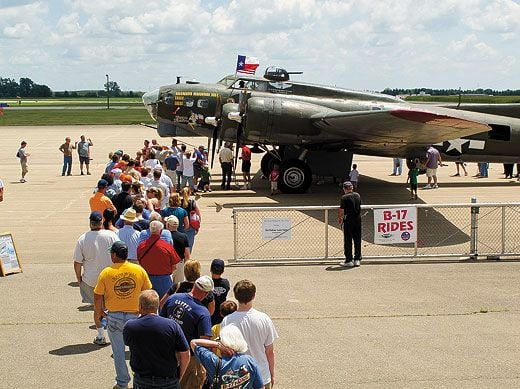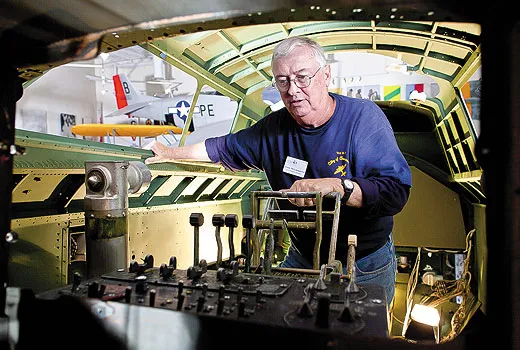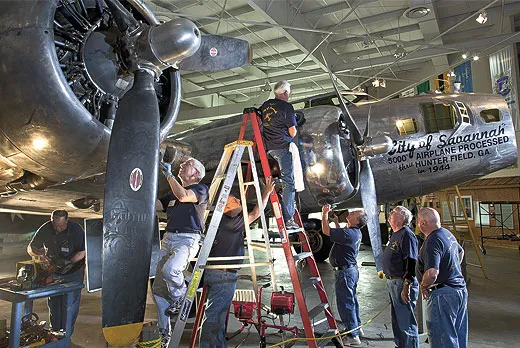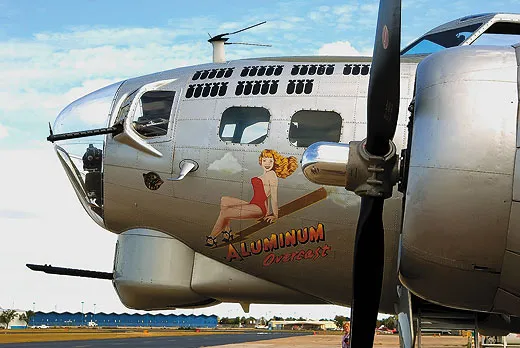At the B-17 Co-op
Like bomber crews on 100-plane raids, today’s B-17 owners find strength—and survival—in numbers
/https://tf-cmsv2-smithsonianmag-media.s3.amazonaws.com/filer/at_the_b17_co-op_03012012_11_FLASH.jpg)
USED TO BE, THE ONLY place you saw a Boeing B-17 was at an airshow or in a museum. But in recent years, the World War II bombers have become an increasingly familiar sight in the skies over American cities. Of the 10 that still fly, about half spend the year traveling from city to city and stopping over for a few days at various airports, where they invite the public to visit. The curious can touch the wings, run their hands over the fuselage, even come aboard and see what a vintage bomber looks like inside.
For about $425, they can buy a half-hour “flight experience.” The people who manage the bombers don’t like to use the word “ride,” because they say their purpose isn’t to entertain, but to educate. They want the public to understand what the bombers did and what their crews went through.
Owning a B-17 is extremely expensive. Hangar rental, maintenance, insurance—all run thousands of dollars a month, and that’s just to keep it on the ground. Once a B-17 takes to the air, the costs jump to thousands of dollars an hour. Only very wealthy individuals and organizations with energetic fundraising staffs can foot the bill.
But operating a B-17 requires more than wealth and a love of aviation history. It takes a certain type of personality. “That airplane demands so much of you that it forces you to be an alpha,” says Tommy Garcia, a civil engineer in Houston and board member of the Texas Armed Forces Historical Society who guided a number of B-17 restorations. Recently, success in operating a B-17 has one more requirement: realization that you can’t do it alone. That’s how the B-17 Co-op got started.
The youngest B-17s flying today were built in the early- to mid-1940s, and no matter how well they are treated, they are very old airplanes. Although most bomber teams have thousands of spare parts in inventory, it’s never enough.
During World War II, the idea was to build as many aircraft as possible, as quickly as possible. Bombers that came back from a mission shot up were repaired slap-dash so they could fly the next day. Nobody worried much about long-term maintenance issues, because most aircraft didn’t last long.
Today, every flying B-17 is lavished with attention that the original crews would have found bewildering. Whenever the airplanes are not being flown, they’re being worked on, cleaned up, or prettified. Every 20 years or so, they are taken apart, sandblasted, and treated for corrosion. Parts get rebuilt or built from scratch, and inspected by a certified mechanic.
One might think that sharing a unique passion for a rare, historic aircraft would create a brotherhood among the owners, but the opposite has been the case. The competition is cutthroat among B-17 owners whose airplanes tour—and fight for the money those tours bring in, which is needed to help defray operational costs. In the process, toes get stepped on and resentments fester. The owners’ mutual distrust often extends to the crews as well. For years, none of them would even talk to one another, and those who tried were ostracized. The problem: With spare parts no longer plentiful, crews hoarded the parts they had.
The B-17’s life after the war is a story about generations: how things get passed on, how one generation differs from the one before it, how things continue as before. By now the first warbird generation, the men who had spent their military careers flying and working on -17s during the war, is almost entirely gone. The generation who took over the aircraft from them began to realize that unless they all found ways to work together—at least on some challenges—the bombers could not continue to fly. That generation, which came of age in the 1960s and ’70s, has been instrumental in getting the B-17 people to finally talk to one another. “We had to keep from having to continually reinvent the wheel,” says Charlyn “Chuckie” Hospers, who, until recently, owned a B-17G named after her.
Evolution of the Co-op
Tommy Garcia was still in his teens when he came aboard the Confederate Air Force wing in Houston, which, a few years earlier, had acquired a B-17G named Texas Raiders. With its olive drab paint job and top turret, Texas Raiders had the outward appearance of a wartime B-17, but Garcia soon discovered that on the inside, it was “just a tube.” The bomb bays, machine gun mounts, and other military equipment had been removed years earlier. It wasn’t that the CAF people weren’t interested in restoring it: their approach was just more laid back. Garcia remembers how those conversations went: “So they might have had a turret—‘Okay, fine, we’ve got one, we’ll put it on one of these days.’ But they didn’t have any real push to get to that level. And our generation came along and we got into that.”
Garcia began hunting down technical documentation and engineering drawings. The CAF’ers started finding missing parts or recreating the ones they couldn’t find, and began slowly restoring Texas Raiders. The Confederate Air Force Arizona wing, which had acquired Sentimental Journey in 1978, and the Experimental Aircraft Association, to which Aluminum Overcast was donated in 1983, were following the same tortuous path.
In his search for parts and documentation, Garcia crossed paths with Jim Peters, one of Sentimental Journey’s maintenance officers. “We began to communicate, sharing things with each other,” recalls Garcia. Eventually, they formed an alliance.
When William D. “Doc” Hospers, an orthopedic surgeon and pilot from a Fort Worth suburb, found an all-but-abandoned B-17 on an old airstrip in Dothan, Alabama, in 1979 that Dothan Aviation had used for 13 years to spray insecticide on fire ants, the alliance gained some muscle. Even though the deal for the aircraft Hospers promptly named Chuckie, after his wife, included several trailers full of spare parts, he found that there were still parts he needed. But when he approached the various bomber groups to see about swaps, all he got was the cold shoulder.
Hospers kept reaching out and eventually got Jim Peters, Tommy Garcia, and some Aluminum Overcast people to meet him. “That first meeting we had was in the Dallas-Fort Worth area at an old hotel, and my husband got up and started talking,” recalls Chuckie Hospers. “He had a chart, and the first thing he wrote on it was ‘SURVIVAL,’ and I’ll never forget that. He said, ‘This is all about survival for all of us, and keeping communication open.’ After that, we thought it’d be a good idea to expand it to the other B-17s. That’s how it started.”
According to Garcia, beefing up the alliance created a new synergy. “By having restored the Texas Raiders back in ’84, ’85, my knowledge base on how to do the whole airplane was there. Jim Peters, being a mechanic by trade and a flight engineer during the war, knew the plane intimately from that end of it. And then Hospers, now being an owner of the aircraft and a pilot, completed the circle for us. The three major talents are right there together, and that becomes the nucleus of the co-op.”
In the mid-1980s, companies that had been providing fire-bombing services to the U.S. Forest Service began selling off their B-17s for newer aircraft. “All of a sudden, here are all these people with all these big-ass airplanes,” says Garcia. “They want to restore them. They want to have a good time with them and make money. Where do they go? They haven’t got a clue. Then they start to realize there is the triangle, us, sitting there with all this information. So they start coming to our meetings and we lure them into the group.”
Each year one of the owners hosts the B-17 Co-op meeting, usually at a hotel close to the airport where that bomber is berthed. The owners sit around a large table, while behind them, in chairs lining the walls, their assistants, operations chiefs, and mechanics eye one another silently. By now most of the support crew members know one another, but they are usually careful not to advertise it, since a certain level of distrust still exists among the groups.
Strength in Numbers
At a recent meeting in Fort Worth, hosted by Chuckie Hospers, the Texas Raiders team has decided to lend a damaged spare set of horizontal stabilizers to Ray Moore in South Carolina, who is building a B-17 practically from scratch. In return, Moore will fix the damaged set, then copy it and make a set for himself and one for another project. Helping Moore is in keeping with the new spirit of cooperation. Now, someone observes, if only Moore can figure out where to get a set of wings.
In a few months, some of the bombers will start on their national tours. They need to come to some agreement on their visitation schedules so that one doesn’t show up in a city only to find out another bomber just left. Everyone knows this is easier said than done. They just hope that if they don’t work it out as a group at the table, they might do it afterward by themselves at the bar.
It’s time to place another order for main-gear tires. They’ve got a specialty tire manufacturer in England with the molds for B-17 tires, which need replacing after 75 to 100 landings, and he’s ready to do another run. The more tires he makes, the lower the per-unit cost and the less it will cost to ship them. How many does everybody want? Then the subject turns to spark plugs. Do they all still have enough, or can they wait another year before putting in an order? They go back and forth and decide it can wait another year, at least.
What about brake expander tubes? They’re a key part of the B-17’s braking system, and by now much of the rubber has deteriorated. The company offering to make them won’t start tooling up unless the co-op comes up with $75,000 worth of orders—about 100 sets. So how many brake expander tubes does everyone want?
An Aluminum Overcast rep mentions how that team thought they had three spare sets that were still good, but when they slapped on one set, no sooner were they up in the air than it started leaking fluid. They were able to land and put in a new set—it’s holding fine, but it did reduce their complacency a tad.
Then Chuckie Hospers announces she’s decided to sell her bomber. Since Doc died the previous March, the toil of running a bomber along with the Vintage Flying Museum, established in 1990, has gotten to be too much. It’s already a done deal. Jerry Yagen of the Military Aviation Museum in Virginia Beach will take delivery of Chuckie in January, though he promises to bring it back in the fall for a hangar dance at Hospers’ museum.
Everyone looks at everybody else. The idea of Chuckie going to Yagen makes sense: He has some 30 airworthy warplanes and a bunch more in restoration. High time he added a B-17.
For a moment, they’re all thinking about what this means: the end of an era. Chuckie and Doc were part of the crew that set up the co-op. If not for those two, the B-17 teams still might not be talking to one another.
Plays Well With Most Others
Don Price of Texas Raiders says that even when there’s a little bit of uncooperativeness from the top guys in the “head sheds,” “the people in the trenches help each other.” After being down eight years for a main wing spar replacement, Texas Raiders ran into problems on its first long tour. “I can tell you we got a lot of help from Yankee Air Museum [in Michigan, which sells rides in Yankee Lady], and the Liberty Foundation [of Tulsa, Oklahoma, which toured with Liberty Belle until the bomber caught fire last June] helped us with one of their mechanics, and then Sentimental Journey sent a couple people over,” Price says. “Some people who helped us, I can’t tell you who they were. They’d say things like ‘The people who run the organization wouldn’t be happy about this.’ But the operators tend to look at it like ‘This could be me broken down next year and I’d need their help.’ ”
A couple of years ago, the guys from Aluminum Overcast came across a huge bonanza of B-17 parts in the city of Red Deer, Alberta, Canada. Says John Hopkins, an Experimental Aircraft Association maintenance manager: “Brake drums, wheel assemblies and landing gear jack-screw assemblies, drive links for the main gear, main gear axles, flap links, cowl flap components, several engines. Plus a box of 120 brand-new, still-in-their-wrappers turbo cooling caps. Turbo cooling caps erode over time because they’re in the pathway of the exhaust. They’re non-existent. You just can’t find them.” Hopkins says his team has no intention of hoarding them. “We get a call from anybody, we’re more than happy to share because we’ll never use 120 cooling caps. Everybody else can use them.”
Even competitors recognize that the reason for keeping these aircraft flying is not entirely ego. “They know what that plane means in our society, what it represents, and they all want to be part of it,” says Tommy Garcia.
“I had a gal who flew with us in Orlando a few years back,” recalls Sean Elliot, flight operations director for the Experimental Aircraft Association. “When she came off [Aluminum Overcast], she was in tears. I went up to her and asked if anything was wrong with the flight. ‘No,’ she said. ‘It was wonderful. My father was killed in April of 1943 over the Black Sea, returning from one of the raids in Germany, and the airplane was lost. I was born in May 1943, so I never knew my father, and the flight gave me a connection to him I never had.’ ”
Back at the annual meeting, eventually the discussion turns to the bombers that aren’t attending. Usually most of the active bomber teams manage to send representatives, but the restoration projects are a different story. Some stay in close contact. The Mighty Eighth Museum’s City of Savannah, for instance, is Tommy Garcia’s current project. The museum has a B-17G that the Smithsonian’s National Air and Space Museum gave it in 2009, after it sat in storage for 25 years. Now, under Garcia’s mentorship, the Mighty Eighth crew is restoring it to a wartime configuration. According to the deal they cut with the Smithsonian, it will never fly again. But Garcia helped convince the crew to make it airworthy, just because they can.
Then there’s Mike Kellner and Desert Rat, the B-17 he found in pieces in a Maine junkyard in the mid-1980s. He bought it for around $7,500, then transported the pieces, a few at a time, back to Marengo, Illinois, where he’s been rebuilding it in a barn. Kellner showed up for a couple of meetings a long while back, but has been scarce ever since. Still, the co-op keeps tabs on him, and word is that Desert Rat is starting to look like an airplane again—with help from volunteers, including riveters, and from Ray Moore, who built Kellner a fuselage jig to hold sections in alignment.
Another restoration project that has the co-op’s attention is the Champaign Aviation Museum’s Champaign Lady, which is being assembled in Urbana, Ohio, from the scraps of several bombers. Among the scraps are a top turret that spent 65 years under a porch, and parts from a B-17 that crashed in North Carolina in 1980. (Last August, Champaign volunteers retrieved parts from a -17 that crashed in Alaska in 1951; at least 15 percent will be used on Champaign Lady.) A while back the co-op would have dismissed Mike Kellner, Ray Moore, and Champaign Lady project manager Randy Kemp as nuts. By co-op standards, and for what they’re trying to do, their revenue streams are pathetic. But no matter what, they keep going, and some time in the next 10 years or so, they’ll probably all be flying.
Then there’s Paul Allen. The Microsoft co-founder is an avid collector and restorer of vintage warbirds. During the late 1990s, he bought an airworthy B-17E that had spent the 1980s hauling beef carcasses around Bolivia. He had it flown back to his museum in Washington state and set his restoration staff to returning it to wartime configuration. When it comes to vintage warbirds, most restorers are obsessive, but Allen’s attentiveness to detail is downright fetishistic (see “Crown Jewels,” Oct./Nov. 2004). Nobody has heard anything from his shop in years. Word is that his restoration had gotten so expensive that he’d given up and shelved it. Some speculate that even with their hand-to-mouth operations, Kellner, Moore, and the Champaign Aviation Museum will probably get their airplanes in the air before Allen does.
The meeting wraps up. They’ve agreed to some things; others are unresolved. Deals have been made and differences have been ironed out. Resentments continue to fester. Everybody shakes hands all around, except for those who don’t.
Brendan McNally is the author of Germania (Simon & Schuster, 2009), a novel about the Third Reich’s Albert Speer, who was the minister of armaments and war production. McNally lives in Dallas, Texas, where he writes about roller derbies, acrobats, Bonnie and Clyde, and other local characters.
